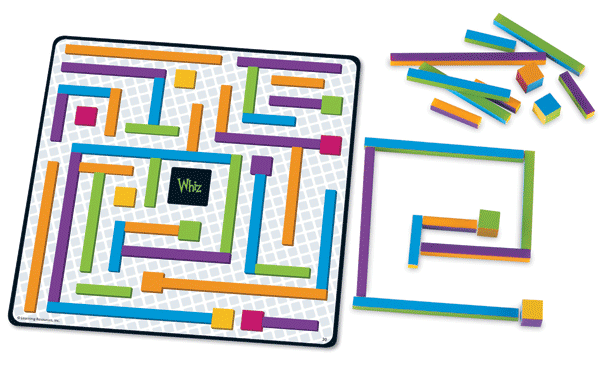What's the game about?
This game includes 25 double-sided pattern cards or "mazes" like I like to call them. They come in 3 levels of difficulty:

The objective of the game is to be the first person to find the path that connects two cubes on the card without any blank spaces between them and to replicate the path using the included multicolored sticks and cubes.

The first one to complete the correct pattern wins.
Skills that helps develop:
Figure Ground- finding the squares inside the cardboard (especially in brainiac level) requires to discriminate between the figure you are looking for (square) and the rest of the background (sticks). Finding the correct path hidden between many fake paths also works on this skill. Figure-ground discrimination is helpful in finding the right notebook or pencil inside a school bag. It's also used when you need to find a specific word inside a paragraph or text.
Visual Tracking- Once you find a square, you need to visually track the whole stick pattern to see if it gets you to another square without any blank spaces in between. Some kids have difficulty with smooth eye movements and they skip words or letters when reading or copying.
Visual discrimination- The hardest part of this game for my OT kids has been discriminating the correct size of the sticks without measuring it against the cardboard. Some even have difficulty choosing the right colors (a con of this game is that some of the colors in the cardboard don't match exactly to the colors on the sticks and cubes). Visual discrimination is important in differentiating between similar geometrical shapes (such as differentiating between a square and a rectangle), letters and words.
Spatial Relations- When replicating the maze, kids have to put the pieces in the correct angles and position. This skill is evidently used in math classes, but is also needed for simpler things such as following directions and avoiding letter reversals (ex. b and d).
Adaptations:
The game is intended for kids 6 years old and up. For younger kids or children with severe visual perceptual difficulties, I make them match the pieces to the cardboard. It's easier and stills works on the wanted skills. You can ask them which size they think will match the picture before they try to put in on to make it more challenging.
The game is intended for kids 6 years old and up. For younger kids or children with severe visual perceptual difficulties, I make them match the pieces to the cardboard. It's easier and stills works on the wanted skills. You can ask them which size they think will match the picture before they try to put in on to make it more challenging.
This game is intended to be played by 2-4 players. Since I usually give therapy sessions one to one, is not as fun for the kids. It's one of those activities that they complete, but don't ask for it the next time. When I've had the opportunity to take kids in small groups, they seem to enjoy the game a lot more.
If you are giving therapy one to one, another option for making the game more interesting is to time the kids and challenge them to complete the next one in less time.
*Bonus tip- If you want to work deeper into visual-motor skills you can make the children draw the maze with crayons in a paper after building it.
Have you used this game in therapy or at home before? Do you have any other ways of using it? Let me know in the comment session.
Note: I am not being paid for posting about this product. I bought this item at full price just like anyone else. This is my honest opinion about the item.

